For over 25 years, Junction City was home to the Peoria Art Guild’s Fine Art Fair, one of the area’s signature cultural events, which takes place every September and enjoys a national reputation as one of the top fairs in the country. Just over a decade ago, the Fine Art Fair moved to its current location at the Peoria RiverFront.
Because the artists featured at the Fine Art Fair come from all over the country, the Art Guild wanted to develop another fair focused on the amazing pool of local artistic talent. In 2006, the Guild once again teamed up with Junction City Ventures and its retailers to host the Art Fair at Junction City.
In this, its fourth year, the fair will feature 50 local artists, who all reside within a 100-mile radius of Peoria. They cover a variety of media, including jewelry, ceramics, painting, photography, glass, wood, mixed media, 2D, sculpture and wearable fiber. The following pages provide an opportunity to get to know five of the participants in the Art Fair at Junction City and get a taste for their work. To find out more about these artists— and the other 45 artists at this year’s fair—stop by the Junction City Shopping Center at 5901 N. Prospect in Peoria on June 6th and 7th. For more information on the fair itself, contact Stacy Peterson-Steiner at 671-1093 or [email protected].
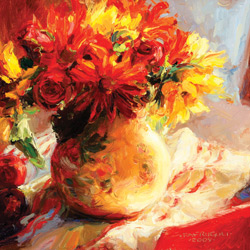 Tracey Frugoli
Tracey Frugoli
2008 Winner, Best in Show
Tracey Frugoli has been painting with oil since 1999, working in the Peoria area for about nine years. She freelances for American Artist’s quarterly periodical, Workshop, and is the Illinois/Midwest regional editor for Fine Art Connoisseur. Born in Chicago, Frugoli has a BFA from Illinois State University and an MA in Art Therapy from Southern Illinois University.
She would often watch her father sketch as a child, and he encouraged her to study art, providing materials and support. Through his example, she discovered her own aptitude for creative work.
As a direct painter, technique is very important to Frugoli. She typically works on her paintings while they are still wet, not waiting for layers to dry. This allows her to control her edges and brushwork, and “impart and sense the energy and movement” of her work. She sometimes chooses a subject that she recognizes as popular, but her work does not cater to the masses. “Painting for anyone other than my muse is certain death to inspiration to me,” she explains.
Frugoli enjoys painting alongside other artists, and has a portrait painting group at her Peoria studio. She also travels to en plein air painting events—French for “in the open air”—where she paints outdoors. Garnering inspiration from the natural world, Frugoli is interested in how light affects her subject matter. Having learned about her craft from past and present representational painters, she has gained new inspiration for her own work.
Frugoli feels that, as an artist, it is her responsibility to produce art that benefits society. While she went through a phase of creating art to challenge society in the past, after 11 years as an art therapist, she felt that there was too much ugliness in the world. Seeking to create works that are beautiful and healing, she now focuses on artwork that “feeds the soul.”
Frugoli has participated in the Art Fair at Junction City since its inception. This year, she is looking forward to showcasing smaller, more detailed works. Because she makes her living by selling her artwork, she is drawn to art fairs like this one, as it provides an excellent venue to meet potential patrons. She also likes to observe people’s reactions to see if her intended impact came across.
Art is like breathing for Frugoli—it is part of her soul. Through painting the natural world, she feels a connection with “that which is greater than me.” She feels humbled, and believes her patrons can have that connection too. Frugoli said, “Some people look to prayer, to God, to the Buddha, to nature, or to each other. Whatever it may be, these paintings—these experiences—are my prayer.”
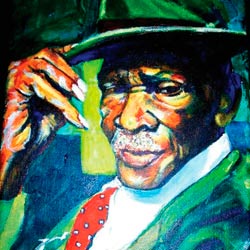 Adrienne Risby was born and raised in Alexandria, Virginia, and has lived in Hawaii and California, but has made Peoria her home for the past 28 years. She didn’t study art in school and never obtained a degree—something which used to make her feel self-conscious around other artists. But does one who has been called “prolific” by her instructor need a degree in art?
Adrienne Risby was born and raised in Alexandria, Virginia, and has lived in Hawaii and California, but has made Peoria her home for the past 28 years. She didn’t study art in school and never obtained a degree—something which used to make her feel self-conscious around other artists. But does one who has been called “prolific” by her instructor need a degree in art?
Risby has drawn portraits since she was a child. Over the years, she left and returned to her craft several times, but has found a renewed fervor for it since her children have grown up. Most of her work consists of portraits, but her success has allowed her to explore other avenues, like abstract painting. “I do the portraits, and that gives me the money to keep my studio going, and I do paintings with that time.”
A very spiritual person, Risby said, “I believe there is a reason why [God] has given me [this] talent.” There have been times “when I’ve said ‘Forget this; this isn’t going anywhere, it’s a hobby.’ No, it’s not a hobby—it’s like a sixth finger—it’s part of me, and as long as I’m doing it, I’m happy.” From time to time, when Risby gets frustrated with her art, she steps back and asks God for guidance on where to go next.
“I’m an artist who paints intuitively,” says Risby. When painting a portrait, she tries to find something about her subject that really touches her. “It might be a picture of a child, and something about the smile, something about those eyes, something about their innocence will help me execute it.” When she finds that something, it doesn’t take long to complete the piece. “I’ll get into it, start painting, and boom, it’s done. And when I’m finished, everything I felt about that painting shows.”
Risby credits local artists Preston Jackson and Vin Luong with providing guidance in her creative path. Working as a resident for Jackson for eight years introduced her to new styles and techniques, while Luong was someone from whom Risby could get honest critiques of her work. “Family members tend to just tell you you’re good,” she noted, although she greatly appreciates the constant support of her family and friends. “My parents always pushed me to keep at it,” she said.
Last year was the first in which she participated in the Junction City Art Fair, and she received a very favorable response. This year, she will showcase a themed body of abstract paintings.
Always striving to be a better artist, Risby took painting classes at ICC to learn structural things about the medium, not having had a formal art education. She is always trying new things and seeking to stretch herself beyond her comfort zone as an artist. Earlier this year, she painted murals at her church and loved every minute of it. Peoria certainly hasn’t seen everything this artist has to offer!
Randy Carlson grew up in Princeton and is currently an associate professor at Bradley University. He studied at Luther College and went on to the University of Iowa, where he completed an MA in printmaking. He then graduated from Bradley in 1989 with an MFA.
When he entered college, Carlson intended to study painting, but became more interested in ceramics and pottery. “I got a sense of the history, and the deep links into prehistory of the artifacts left behind. The heritage of ceramics was really intriguing to me, as was the whole process and use of the material, and the transformation of the materials…was a real hook for me,” he explained.
Carlson has been active in ceramics for most of his adult life, but is also interested in printmaking, drawing and painting. He lived in Maine for two years, working with pottery and doing a residency at the Center for Ceramic Arts. Then he decided he wanted to be closer to home, and was looking for more academic opportunities, so he moved to Madison, Wisconsin, and then back to Peoria in 1993.
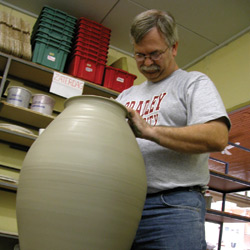
An accumulated awareness of historical pottery forms from all over the world inspire Carlson and create new ideas for his work. “I make subtle variations…through continued exploration of materials and specific firing. The surfaces and materials have a tendency to become more interesting and reveal more and more to me the more I do it.” He also notices forms in nature, history, old paintings, and even movies and television dramas, and often considers traditional pottery from the European and American traditions centered on the stoneware genre.
Carlson has participated in the Junction City Art Fair since it started and really appreciates its regional focus. This year, he will showcase functional, useable ceramic objects, some of which are very sculptural.
Before the fair, Carlson plans to fire at least a few loads of ceramics. The individual pieces can take any length of time to create. “Some of the pieces can be thrown directly on the wheel in only a few minutes,” he noted. “There’s a whole variety of forms that start out on the wheel, but are substantially altered by cutting and adding other pieces and really redefining the forms in pretty drastic ways. Those can take almost a day, and I will work on them in a series of three or four pieces. So, it can take three or four days. You can shortcut some of those things, but I tend to feel that can put unnecessary strain and stress on the form.”
Of course, whatever is made is based on previous work and cumulative experiences. So, as one of Carlson’s previous teachers said, in a way, the work has taken a lifetime.
Angela Dieffenbach
2008 3rd Place Winner
Angela Dieffenbach grew up in Princeville and began her college career majoring in physical therapy, before discovering her true passion was for art. She became interested in ceramics at Bradley University, where she graduated with two undergraduate degrees, a BFA in ceramics, and a BS in K-12 art education. One of her many inspirations is Bradley Professor Randy Carlson, who will also be presenting at this year’s fair. Her own interest in teaching gave her an appreciation for Carlson’s emphasis on leading students in the right direction.
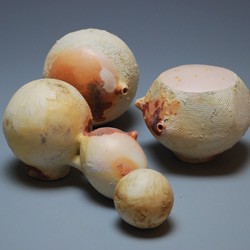
Last year was Dieffenbach’s first year participating in the Art Fair at Junction City. She is drawn to this particular fair because it presents a very interesting group of artists, and she feels that there is a greater opportunity to communicate and spend time with them. She really enjoys meeting other artists and hopes to collaborate with another artist on a project in the future. She also enjoys talking with the people who view her artwork, and feels that the Junction City Art Fair is a great place to do this.
Dieffenbach is currently working on a collection of ceramics about prescription drugs that she will present at the fair. Last year, she was diagnosed with Crohn’s disease, and has found inspiration for her ceramics in the different skeleton formulas from medications. She currently works with a retired chemistry teacher who is teaching her how to read the formulas, and she creates sculptural vessels after learning about them.
Her art is an effort to understand what is happening to her and lift her experience to a new level. “I’m trying to figure out what might or might not be wrong with me, and I am really inspired by what is going on with my body,” says Dieffenbach. “I am curious, and so I do all of this research and I think about elevating it to a more beautiful level, hoping the drugs will do what they need to do, and trying to see them as beautiful objects.” She also wants to acknowledge the scientists who make the drugs, because in creating them, they become artists themselves.
Dieffenbach is in the beginning stages of creating new glazes for her ceramics using various drugs. “I look at what components comprise the different drugs, and do tests at different temperatures to see where they melt at, and then also use ceramic glaze components…and combine them with the drugs to lower or raise the melting point, to achieve the surfaces I am looking for.” She composes her pieces in a manner she hopes will keep the viewers interested and really cause them to think about the issues she portrays.
Dieffenbach is currently working toward her MFA in ceramics at the University of Iowa, and is looking forward to returning to Peoria for the Junction City Art Fair.
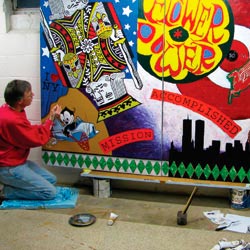 Brian Sullivan
Brian Sullivan
2008 2nd Place Winner
Growing up, Brian Sullivan wasn’t raised or surrounded by artists; he came to art on his own, taking his first class in high school. “I didn’t know that people did art for a living until I went to college,” he said. While he had always been artistic as a child, it was in college that he really explored all avenues and blossomed as an artist.
Sullivan continues to explore a variety of artistic mediums, including painting, sculpture, printmaking, drawing and photography. This year, his fourth at the Junction City Art Fair, he will be showing a series of large oil paintings on canvas. While he participates in a number of shows each year, he said, “I really like this Junction City one…because they treat you well and it’s a really nice set-up. The people who come out support the arts and really enjoy talking with you and asking you questions, so it’s fun to do.” The boardwalk arrangement of artist booths at Junction City also allows room for his canvases, many of which will be 6’ by 4’. With such large pieces, it’s sometimes impossible for him to participate in small, tented shows.
Each of Sullivan’s paintings is made up of several images, all of which are found objects. “My art has always been in found objects,” he explained. “I can’t just go and paint a pretty picture…I have to sort of find my objects.” An antique collector on the side, Sullivan truly values the “rich visual history of nostalgic things,” which is clearly seen in his paintings.
“It’s really important for me to look at new books and magazines—to go out to places. I need that subconscious stimulation to bombard me with hundreds of thousands of images and pictures because that’s where I draw from. The bigger the library in my head is, the more visual I can make my pictures.” The actual painting process goes quickly for Sullivan—it’s the finding of the objects and the assembling of pieces which together tell a story that’s extremely time-intensive.
What drives Sullivan’s artwork is his internal questioning: “What can I add that’s different?” He always strives to dig deeper and continually come up with new ideas. “I don’t just want to make another pretty picture for people to hang in their living room,” he explained. The past 30 years of his work have been a testament to that statement, as he has explored the social/political genre and strives to “reflect the injustices and inequities in America.”
To accomplish this, Sullivan removes himself from the art. “I want my work to be interesting whether or not I’m here or I made it,” he says. In each piece, he isn’t looking to create a single message; instead he wants viewers to experience something different every time they look at it. “The message,” he reported, “is about the work and the people. It’s not about me.” a&s
This year’s fair is expected to draw 10,000 people and will be supported by 150 volunteers. For more information on volunteer opportunities, email [email protected] or visit peoriaartguild.org.


